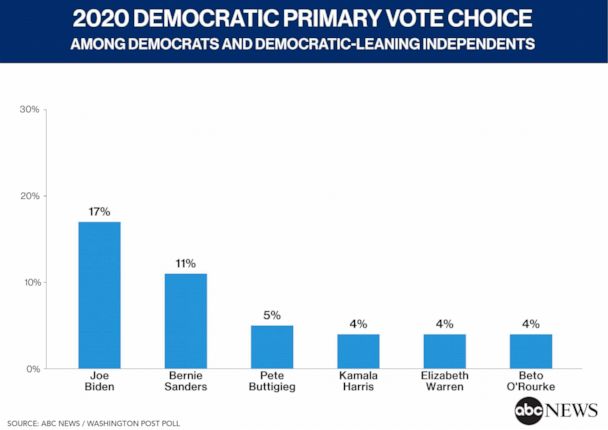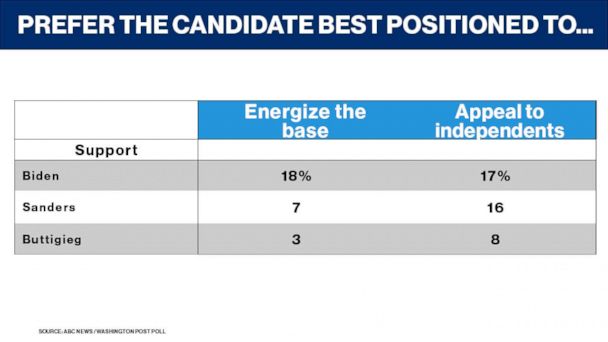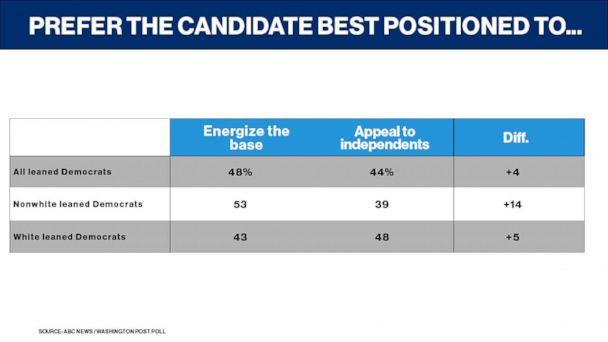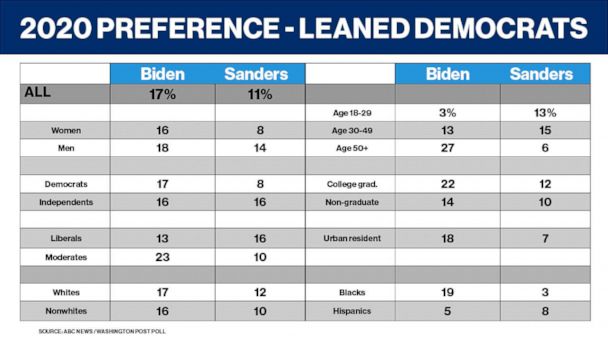Biden takes the Democrats' early lead, with signs of a generational showdown
Joe Biden enters as the frontrunner for the Democratic presidential nomination.
Joe Biden enters as the early frontrunner for the Democratic presidential nomination in the latest ABC News/Washington Post poll, albeit with a decided tilt toward older voters that could define the party’s 2020 contest as a generational showdown.
In an open-ended question, 17% of Democrats and Democratic-leaning independents back Biden, with 11% for Bernie Sanders, 5% for Pete Buttigieg, 4% apiece for Kamala Harris, Beto O’Rourke and Elizabeth Warren and 1 or 2% for Cory Booker, Amy Klobuchar and non-candidates Hillary Clinton and Michelle Obama.
See PDF for full results, charts and tables.
Much can change, as evidenced by the 35% who have no opinion, and it’s unsurprising that the two leaders are those with the broadest name recognition – a former vice president and the party’s 2016 runner-up. Long expected to run, Biden announced his candidacy last Thursday.

There’s a striking generation gap between Biden, 76, and Sanders, 77, who built his insurgent 2016 campaign largely on support from young voters. Today Biden easily leads Sanders, 27-6%, among those age 50 and older, compared with a 9-15% race – Sanders ahead numerically, albeit not significantly – among those younger than 50. Biden is particularly weak among under-30s, with just 3% support vs. Sanders’ 13% (averaging the last two ABC/Post surveys for an adequate sample size).

That said, age isn’t the only differentiator. As detailed below, Sanders trails Biden, in particular, among women, mainline Democrats (as opposed to Democratic-leaning independents), moderates, blacks, college graduates and urban residents. And the race goes 2-1 for Biden -- 19-10% -- when limited to registered voters in this survey, produced for ABC by Langer Research Associates.
Strategy and Electability
There are intra-party divisions among Democrats and Democratic-leaning independents on strategy and electability. They split, 48-44%, on whether it’s better for the party to nominate a candidate who can best energize the Democratic base or who’s best positioned to win over independents, often the key swing voters in national elections. Leaned Democrats also divide, 47-39%, on whether they’d prefer a candidate who’s closest to them on the issues or who has the best chance of defeating Donald Trump.

The strategy question shows some differences in candidate choices. Among those who think it’s best to pick the candidate who can energize the party’s base, Biden leads Sanders by 18-7%. Among those more concerned with appealing to independents, the two are essentially even, 17-16%. (Buttigieg has 8% support among those focused on appealing to independents, vs. 3% among those more concerned with motivating the base.)
It’s a logical result; Sanders’ support in 2016 came from independents rather than Democrats by nearly a 2-1 margin.

There’s no difference on this question between liberal and moderate leaned Democrats, but there is by race: Nonwhites, by 53-39%, lean toward a focus on energizing the Democratic base, while whites split about evenly, 43-48%. (Nonwhites account for nearly half of all leaned Democrats, 48%, compared with 20% of leaned Republicans.)

For its part, the question of whether leaned Democrats prefer a candidate who’s closest to them on the issues or best able to defeat Trump does not substantially impact candidate preference. Biden has virtually identical support in these two groups, 17 and 18%, respectively; Sanders, 13 and 9%.

Groups
Among demographic groups, Biden has virtually identical support from women and men -- 16 and 18%, respectively -- regardless of reports by several women that he made them feel uncomfortable by the way he hugged or touched them, and criticism of his handling of the Clarence Thomas/Anita Hill hearings in 1991. Sanders, for his part, does a bit better with men than with women, 14 vs. 8%.
Sanders struggled to win support from nonwhites in 2016, losing them to Hillary Clinton, 71-28%, in primaries in which exit polls were conducted. Today Biden leads Sanders among nonwhites overall by 16-10%, including 19-3% among blacks (compared with a close 5-8% among Hispanics).
Sanders also struggled among mainline Democrats and political moderates, losing them to Clinton by 64-35% and 62-36%, respectively. Today Biden has twice Sanders’ support among mainline Democrats and moderates alike.
Biden does slightly better with college graduates than non-graduates, 22 vs. 14%, while Sanders runs essentially evenly in both groups, 12 and 10%. Among others, Warren does 8 percentage points better with graduates than non-graduates, and Buttigieg does 7 points better. Non-graduates, who tend to be less engaged politically, are far more apt than graduates to have no current preference.
In another difference in support profiles, Biden has 18% backing in urban centers, compared with Sanders’ 7%.

Results given in this report are not restricted to registered voters, since there’s plenty of time to register before the caucus and primary season begins in Iowa next Feb. 3. Looking just at registered voters doesn’t make much difference in any case, but for optics: As noted, Biden goes to a 2-1 lead over Sanders, 19-10%.

Regardless, all these results require an important note of context: Early leaders sometimes are nomination winners, but not always. See, for example, Jeb Bush (2016) and Hillary Clinton and Rudy Giuliani (both 2008). Indeed, in crowded Republican races, Ben Carson, Rand Paul and Scott Walker all polled competitively at points in the 2016 campaign, as did Newt Gingrich, Herman Cain, Michele Bachman and Sarah Palin in the 2012 race; all later faded. These are early days in the 2020 race – and if history provides any lesson, it’s that campaigns matter.
Methodology
This ABC News/Washington Post poll was conducted by landline and cellular telephone April 22-25, 2019, in English and Spanish, among a random national sample of 1,001 adults. Results have a margin of sampling error of 3.5 points, including the design effect, for the full sample. This analysis is based on results among 427 Democrats and Democratic-leaning independents, with an error margin of 5.5 points. Partisan divisions are 29-26-36 %, Democrats-Republicans-independents.
The survey was produced for ABC News by Langer Research Associates of New York, N.Y., with sampling and data collection by Abt Associates of Rockville, Md. See details on the survey’s methodology here.